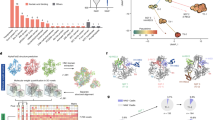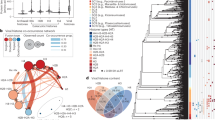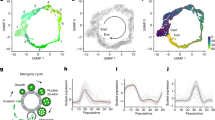Abstract
Certain members of the Escherichia coli plasmid incompatibility group P are capable of efficient transfer between and maintenance in most Gram-negative bacterial species1–4. Of fundamental interest is whether this broad host range results from differences between the mechanisms of replication and partitioning during cell division used by IncP plasmids and by narrow host range plasmids. The genetic regions of IncP plasmid RK2 (similar or identical to RP4 and RP1) required for plasmid maintenance in E. coli have previously been defined as a vegetative replication origin (oriRK2) and a gene specifying a positively required trans-acting product (trfA)5–8. Here we have tested various mini RK2 replicons for their ability to become established after transformation into Pseudomonas aeruginosa PAO as a model non-E. coli host. We chose P. aeruginosa for this purpose as it is a Gram-negative species relatively phylogenetically distant from E. coli. Our studies have defined a plasmid segment that contains a region which must be linked in cis to the oriRK2 replicon to allow mini RK2 plasmid maintenance in P. aeruginosa PAO and suggest that RK2 may carry genes which adapt the basic replicon to allow autonomous maintenance in specific groups of hosts.
This is a preview of subscription content, access via your institution
Access options
Subscribe to this journal
Receive 51 print issues and online access
$199.00 per year
only $3.90 per issue
Buy this article
- Purchase on Springer Link
- Instant access to full article PDF
Prices may be subject to local taxes which are calculated during checkout
Similar content being viewed by others
References
Datta, N. & Hedges, R. W. J. gen. Microbiol. 70, 453–360 (1972).
Olsen, R. H. & Shipley, P. J. Bact. 113, 772–780 (1973).
Beringer, J. E. J. gen. Microbiol. 84, 188–198 (1974).
Cho, J. J., Panopoulos, N. J. & Schroth, M. N. J. Bact. 122, 192–198 (1975).
Meyer, R. & Helinski, D. R. Biochim. biophys. Acta 478, 109–113 (1977).
Figurski, D. & Helinski, D. R. Proc. natn. Acad. Sci. U.S.A. 76, 1648–1652 (1979).
Thomas, C. M., Meyer, R. & Helinski, D. R. J. Bact. 141, 213–222 (1980).
Thomas, C. M. Plasmid 5, 277–291 (1981).
Barth, P. T. in Plasmids of Medical, Environmental and Commercial Importance (eds Timmis, K. N. & Pühler, A.) 399–410 (Elsevier, Amsterdam, 1979).
Haas, D. & Watson, J. Soc. gen. Microbiol. Q. 8, 88–89 (1981).
Birnboim, H. C. & Doly, J. Nucleic Acids Res. 7, 1513–1523 (1979).
Figurski, D. H., Pohlman, R. F., Bechhofer, D. H., Prince, A. S. & Kelton, C. A. Proc. natn. Acad. Sci. U.S.A. 79, 1935–1939 (1982).
Meacock, P. A. & Cohen, S. N. Cell 20, 529–542 (1980).
Miki, T., Easton, A. M. & Rownd, R. H. J. Bact. 141, 87–99 (1980).
Nordstrom, K., Molin, S. & Aagaard-Hansen, A. Plasmid 4, 215–227 (1980).
Robberson, D. L., Kasamatsu, H. & Vinograd, J. Proc. natn. Acad. Sci. U.S.A. 69, 737–741 (1972).
Thomas, C. M. Plasmid 5, 10–19 (1981).
Sternberg, N. & Austin, S. Plasmid 5, 20–31 (1981).
Author information
Authors and Affiliations
Rights and permissions
About this article
Cite this article
Thomas, C., Hussain, A. & Smith, C. Maintenance of broad host range plasmid RK2 replicons in Pseudomonas aeruginosa. Nature 298, 674–676 (1982). https://doi.org/10.1038/298674a0
Received:
Accepted:
Issue Date:
DOI: https://doi.org/10.1038/298674a0
This article is cited by
-
Plant-microbial interaction under gnotobiotic conditions: A scanning electron microscope study
Current Microbiology (1991)
-
Involvement of kil and kor genes in the phenotype of a host-range mutant of RP4
Molecular and General Genetics MGG (1984)
-
Transcription in the trfA region of broad host range plasmid RK2 is regulated by trfB and korB
Molecular and General Genetics MGG (1984)
-
Occurrence of deletion plasmids at high rates after conjugative transfer of the plasmids RP4 and RK2 from Escherichia coli to Alcaligenes eutrophus H16
Archives of Microbiology (1983)
-
Deletion mapping of kil and kor functions in the trfA and trfB regions of broad host range plasmid RK2
Molecular and General Genetics MGG (1983)
Comments
By submitting a comment you agree to abide by our Terms and Community Guidelines. If you find something abusive or that does not comply with our terms or guidelines please flag it as inappropriate.



